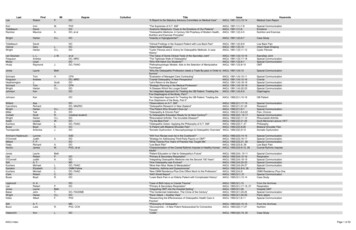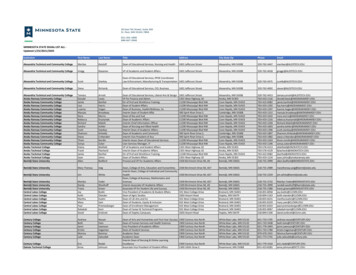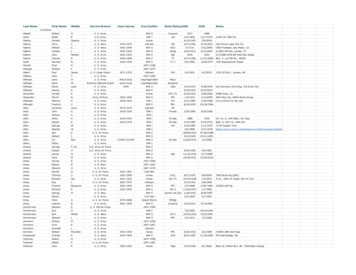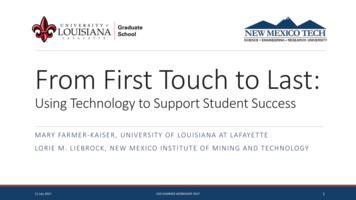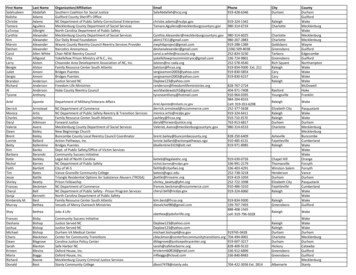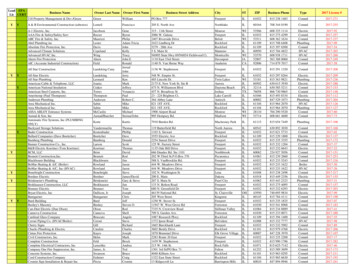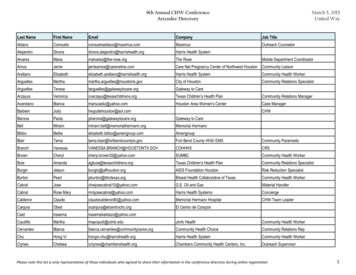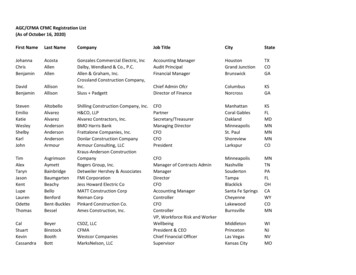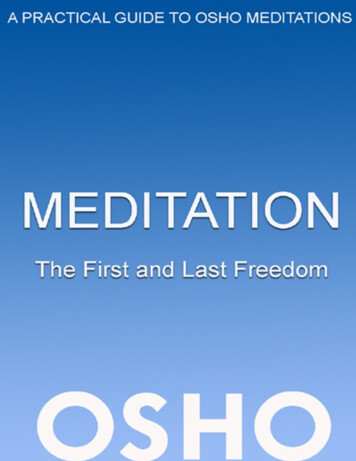
Transcription
MeditationTHE FIRST and LAST FREEDOMA practical guide to OSHO meditationsOSHO
Copyright 1987, 2004 (revised edition), 2009. Osho InternationalFoundation, Switzerland. www.osho.com/copyright. All rights reserved.OSHO and ancillary rights are registered trademarks of OshoInternational FoundationApart from descriptive text written by the editors, the text in this book is selectedfrom various discourses by Osho, given to live audiences over a period of morethan thirty years. All of the Osho discourse series have been published in full asbooks, and are also available as original audio recordings. Audio recordings andthe complete text archive can be found via the online OSHO Library atwww.osho.comeBook EditionISBN 13: 978-0-88050-772-1ISBN 10: 0-88050-772-1OSHO MEDIA INTERNATIONALis an imprint ofOSHO INTERNATIONALNew York—London - Mumbaiwww.osho.com/oshointernational
MEDICAL DISCLAIMERAdvice or teachings given in this book are not intended to replace the services ofa physician, therapist, or psychiatrist. Nor is the book meant to provide analternative to professional medical treatment. This book offers no medicaldiagnosis of, or treatment for, any specific medical or psychological problemsyou may have. Some of the meditations include strenuous physical activity—ifyou have any reason to be concerned about the effects of such activity on yourhealth, you should consult your physician before trying these meditations.
ForewordMeditation is a science, not a superstition. Meditation says that if youexperiment with your mind—it is too full of thoughts—thoughts can bedispersed. The clouds can be dispersed and you can attain to an empty sky ofyour inner being. And it needs just a little courage, a little effort, a little daring, alittle persistence and perseverance. A little patience, yes, but no trust—you don’tbelieve in God? That is not a hindrance to meditation. You don’t believe in thesoul? That is not a hindrance in meditation. You don’t believe at all? That is notan obstacle. You can meditate, because meditation simply says how to gowithinward: whether there is a soul or not doesn’t matter; whether there is a Godor not doesn’t matter. One thing is certain: that you are. Whether you will beafter death, or not, does not matter. Only one thing matters: right this moment,you are.Who are you? To enter into it is meditation, to go deeper into your own being.Maybe it is just momentary; maybe you are not eternal, maybe death finisheseverything. We don’t make any condition that you have to believe, we say onlythat you have to experiment. Just try. One day it happens: thoughts are not there.And suddenly, when thoughts disappear, the body and you are separate, becausethoughts are the bridge. Through thoughts you are joined with the body; it is thelink. Suddenly the link disappear—you are there, the body is there, and there isan infinite abyss between the two. Then you know that the body will die but youcannot die. Then it is not something like a dogma; it is not a creed, it is anexperience—self-evident.OSHO
TABLE OF CONTENTSTitle PageCopyrightForewordMEDICAL DISCLAIMERIntroductionPart 1: ABOUT MEDITATIONWhat is meditation?Witnessing, the spirit of meditationThe flowering of meditationThe great silenceGrowing in sensitivityLove, the fragrance of meditationCompassionAbiding joy for no reason at allIntelligence: the ability to respondAloneness: your self-natureYour real selfPart 2: THE SCIENCE OF MEDITATIONMethods and MeditationsTechniques are helpfulBegin with effortThese methods are simpleFirst understand the techniqueThe right method will clickWhen to drop the methodSuggestions for beginnersEnough spaceThe right placeBe comfortableBegin with catharsis
Guidelines to FreedomThe three essentialsBe playfulBe patientDon’t look for resultsAppreciate unawarenessMachines help, but don’t create meditationYou are not your experiencesMeditation is a knackPart 3: THE MEDITATIONSTHE OSHO ACTIVE MEDITATIONSWhy active meditation?Powerful Methods for AwakeningAn Energy PhenomenonOSHO DYNAMIC MEDITATION: Catharsis and CelebrationRemember, remain a witnessOSHO KUNDALINI MEDITATIONOSHO NATARAJ MEDITATIONOSHO NADABRAHMA MEDITATIONAnything Can Be a MeditationRunning, Jogging and SwimmingLaughing MeditationGibberish MeditationSmoking MeditationBreath—a Bridge to MeditationVipassanaThrowing things outOpening the HeartFrom head to heartThe heart of peacefulnessAtisha’s Heart MeditationInner CenteringAbdullah
Finding the real sourceCenter of the cycloneWho am I?OSHO WHIRLING MEDITATIONMeditations on LightGolden Light meditationHeart of lightMeditations on DarknessInner darknessMeditations in SoundAumDevavaniThe center of soundFinding the Space WithinEnter the clear skyInclude EverythingA meditation for the jet setWatching with the Third EyeOSHO GOURISHANKAR MEDITATIONOSHO MANDALA MEDITATIONFinding the WitnessTouching as a FeatherJust SittingZazenJust ListeningOSHO MEDITATIVE THERAPIESThe OSHO MYSTIC ROSE MEDITATIONThe OSHO NO-MIND MEDITATIONOSHO BORN AGAINOSHO REMINDING YOURSELF OF THE FORGOTTEN LANGUAGEOF TALKING TO YOUR BODYMINDPart 4: OBSTACLES TO MEDITATION
The two difficultiesThe egoThe chattering mindFalse methodsMeditation is not concentrationMeditation is not introspectionTricks of the mindDon’t be fooled by experiencesMind can enter againMind can deceive youPart 5: RESPONSES TO QUESTIONS ABOUT MEDITATIONOnly a witness can really danceThe goose has never been inThe watcher on the hillWhere did you leave your bicycle?Just a 180 turnAll paths merge on the mountainCelebrating consciousnessCount the moments of awarenessMake things as simple as possibleWitnessing is like sowing seedsWitnessing is enoughAppendix: OSHO Active Meditations MusicFor More InformationAbout the AuthorOSHO International Meditation Resort
IntroductionJust as the science and technology that has transformed our outer lives hasbeen largely a Western phenomenon, so the East has provided the main source ofthe science that can transform our inner lives. Today, just like the light bulb,meditation is a universal phenomenon—one helps illuminate our outer world,the other our inner world.But in the process of becoming universal, many misconceptions aboutmeditation have arisen: that it is “religious,” that it is about sitting in difficultpostures, perhaps with your ankle round your neck and a holy look on your faceto hide the discomfort; maybe even humming, or chanting some esotericsounding mantra.If that doesn’t appeal to you, then this book is for you.Here, meditation is made simple, ordinary, and the natural component of acontemporary life style. And increasingly, an essential component too.Meditation in its essence is the art of being aware—aware of what is goingon inside you and around you.Although meditation itself is not a technique, there are many methods hereto help you learn this awareness, and as you acquire this knack, it can be yourcompanion wherever you are—at work, at play, wherever.Most of us have been taught that in order to be successful in life we need tostruggle, to fight, to focus, to concentrate. The trouble with this approach is thatthe more we struggle, the more tense we become. And the more tense we are, theworse we perform. The meditative approach is to understand that in order to beat our best, in order to give each moment our best—and to receive the best fromeach moment—we need to be as aware as possible. And to be aware we need tobe relaxed.Usually we think that in order to relax, we have to go out. Meditation offersanother possibility: to go in to relax.Such are the pressures of modern life that there has never been a morerestless world to live in. Never have people been so tense. It is exactly for themodern mind that these techniques have been devised—a contemporaryapproach to suit contemporary people.If you are a high-energy individual, for example, for whom “just sitting”seems impossible, then try the Osho Active Meditations: Osho Dynamic or OshoKundalini. Exert yourself to the maximum and let the relaxation follow of itsown accord. Perhaps your pent-up emotions make it difficult to sit quietly? Or
you feel too tired and lethargic to stay awake while trying to sit? Or perhaps youjust want to move your body. Then, again, these Active Meditations are just foryou.The knack of remaining relaxed in the midst of our busiest day is what hasbeen called “alertness with no effort”—the essential experience of meditation.So even if you are convinced you have absolutely no time to set aside formeditation, you’ll find plenty of techniques in this book that can be seamlesslyintegrated into your day.Meditation is based on a simple understanding: Rather than fighting withdarkness, which is impossible anyway, switch on the light. Rather than fightingwith ourselves, trying to improve ourselves, trying to live up to others’ ideas ofwho or what we should be, we can start by simply accepting ourselves as we arenow.Osho often reminds us that if existence has invited us to be here, who else’spermission do we need to accept ourselves as we are? Once we relax into thisacceptance, once we stop pretending to be other than who and how we are, oncewe stop struggling to impress others (who are struggling equally hard to impressus), once we stop trying to defend ourselves, justify ourselves. Once we stoptrying to hide our wounds, even from ourselves, but rather open them to the airand the light, the healing happens on its own.In this book you will read of calming the mind, of learning how thisinvaluable bio-computer can be your greatest friend. And how to find the “off”button. When you need the mind, you can use it. When you don’t need it, youcan let it rest quietly—ready for when you need it again—free from its endlesschattering quality.Someone insults you. Imagine being able to choose when and how torespond, free from the usual knee-jerk reaction to strike back, creating thoseendless vicious spirals in which our relationships can slowly drown.And what of freedom? There is no greater freedom than to be that which wewere meant to be. There is no greater freedom than to be free of others’expectations, to be able to live our lives spontaneously, with awareness.And the ultimate paradox of meditation is that when we finally learn to loveourselves—in fact only when we can love ourselves—are we able to share thatlove with others. But first we must start with ourselves.This book contains a wide range of techniques, approaches, and insights tohelp you on that journey. We are all individuals, and different methods suitdifferent people. Here, there is something for every type of modern mind,
uniquely tailored for these hectic times.As Osho puts it: “The long drawn-out yoga practices will not do for theworld; now people do not have days or even hours to spare. We need methodsthat yield quick results. If a man makes a seven-day commitment, by the end ofthat period he should begin to feel that something has happened to him. Heshould become a different man in seven days’ time . So, I say, practice todayand feel the result immediately. Now it is the jet age; now meditation cannotafford to be slow. It has to pick up speed.”
Part 1: ABOUT MEDITATIONWhat is meditation?Meditation is an adventure, adventure into the unknown, the greatestadventure the human mind can take.Meditation is just to be, not doing anything—no action, no thought, noemotion. You just are and it is a sheer delight. From where does thisdelight come when you are not doing anything? It comes from nowhere, orit comes from everywhere. It is uncaused, because existence is made of thestuff called joy.Witnessing, the spirit of meditationWhen you are not doing anything at all—bodily, mentally, on no level—when all activity has ceased and you simply are, just being, that’s whatmeditation is. You cannot do it, you cannot practice it: you have only tounderstand it.Whenever you can find time for just being, drop all doing. Thinking is alsodoing, concentration is also doing, contemplation is also doing. Even if for asingle moment you are not doing anything and you are just at your center, utterlyrelaxed—that is meditation. And once you have got the knack of it, you canremain in that state as long as you want; finally you can remain in that state fortwenty-four hours a day.Once you have become aware of the way your being can remainundisturbed, then slowly you can start doing things, keeping alert that your beingis not stirred. That is the second part of meditation—first, learning how just tobe, and then learning little actions: cleaning the floor, taking a shower, butkeeping yourself centered. Then you can do complicated things.For example, I am speaking to you, but my meditation is not disturbed. I cango on speaking, but at my very center there is not even a ripple; it is just silent,utterly silent.So meditation is not against action. It is not that you have to escape fromlife. It simply teaches you a new way of life: you become the center of thecyclone.Your life goes on, it goes on really more intensely—with more joy, withmore clarity, more vision, more creativity—yet you are aloof, just a watcher on
the hills, simply seeing all that is happening around you.You are not the doer, you are the watcher.That’s the whole secret of meditation, that you become the watcher.Doing continues on its own level, there is no problem: chopping wood,drawing water from the well. You can do small and big things; only one thing isnot allowed and that is, your centering should not be lost.That awareness, that watchfulness, should remain absolutely unclouded,undisturbed.In Judaism there is a rebellious school of mystery called Hassidism. Itsfounder, Baal Shem, was a rare being. In the middle of the night he was comingfrom the river—that was his routine, because at the river in the night it wasabsolutely calm and quiet. And he used to simply sit there, doing nothing—justwatching his own self, watching the watcher. This night
Meditation is a science, not a superstition. Meditation says that if you experiment with your mind—it is too full of thoughts—thoughts can be dispersed. The clouds can be dispersed and you can attain to an empty sky of your inner being. And it needs just a little courage, a little effort, a little daring, a little persistence and perseverance. A little patience, yes, but no trust—you don’t
![Last or Business First [Maiden] Page Title Notes](/img/1/saukcity125thjubilee-20historical-20album-index.jpg)


